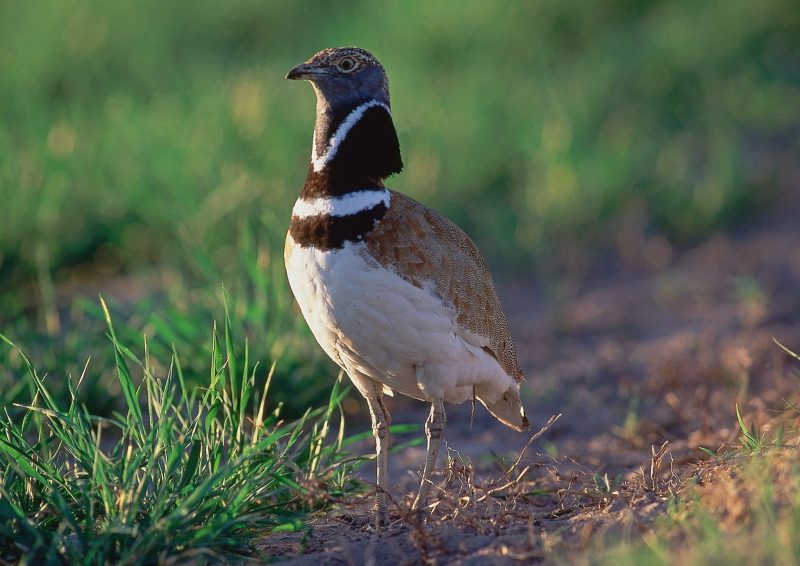To analyze how the climate change affects the aveBy 2024, SEO/BirdLife will tag common little bustards, short-eared owls, some endangered birds of prey and black storks with GPS to track their movements. This allows them to analyze what influence this has on the climate change and our management of the territory for these birds
In a time of global crisis such as the current one, the ave They allow us to know the health status of the planet. Knowing their migration routes and wintering areas provides very valuable information about what is happening. The climate crisis and the loss of biodiversity It is a reality that must be faced with good management of the territory and with information such as that obtained thanks to the Migra program.
SEO/BirdLife’s main goal this year, 2024, is to use a tracking device (GPS) to mark several specimens of the little bustard, a species closely associated with agricultural environments, in order to learn more about their movements and the problems they have in the field of agriculture. their habitats, breeding, wintering, studying what use they make of the land and aspects that will contribute very positively to the good planning of photovoltaic installations.
In addition to facilitating good planning, it will also allow us to know how the thousands of hectares of its habitat that will be occupied with new plants of the species may affect the biology of the species. renewable energy.
Small bustard tagging to learn how climate change affects birds
“Their movements are completely unknown, although it is known that they do not move to the African continent, we do not know how they move between provinces and autonomous communities and what use they make of the territory during the reproductive and winter seasons and movements beyond. of those two periods.”
Knowing in detail the use of the area throughout the year is the key to managing it well and making biodiversity and energy needs of a growing population compatible, acknowledges Juan Carlos del Moral, Citizen Science Coordinator at SEO/BirdLife .
The marking of the specimens will be carried out in collaboration with the Autonomous University of Madrid and the involvement of research centers such as the Institute of Hunting Resources of the CSIC or the Technological and Forestry Center of Catalonia, which has already been carried out in previous years. year and will provide information that will help achieve results within the Migra program this year.
During this season, 17 will be highlighted ave in the autonomous communities of Andalusia, Aragon, Castilla y León, Castilla-La Mancha and Madrid. The population of the little bustard in Spain during the breeding period is estimated at 38,856 males.
87% of the population is concentrated in the grain steppes of the southern half (Castilla-La Mancha, Extremadura, Andalusia, Madrid, Murcia and the Valencian Community). Its evolution is very negative: in 2016, only 52% of male bustards existed in 2005; the last two available national censuses.
Climate change affects birds: following the journeys of the short-eared owl
The distribution of the short-eared owl is clearly concentrated in the northern sub-plateau of the Iberian Peninsula, in the Tierra de Campos region, mainly in the provinces of Palencia, Zamora and Valladolid.
Breeding records are scattered in other provinces, especially in the Ebro Valley, in provinces such as Navarre, Zaragoza, Huesca and Teruel. Appointments in the southern half of Spain are much scarcer and are found on the Mediterranean coast, the Guadalquivir Valley, Extremadura, Madrid and Castilla-La Mancha.
However, in years of demographic explosions of the field mouse, wintering is important and at that time it could be found in a large part of our territory. It is a species with transverse migration, from Eastern to Western Europe, a type of migration that has not been addressed in the Migra program until now. In 2023, marking of 10-20 units is planned in Castilla y León and Andalusia, in collaboration with CSIC-IREC.
How do large birds of prey such as the imperial eagle, Bonelli’s eagle, golden eagle, black vulture or other large birds of prey move and what threats do they face? ave like the black stork? The purpose of monitoring these species is to obtain information that contributes to identifying black spots in terms of accidents and mortality, and to obtain information on the impact that these infrastructure problems have on the populations of these species. ave threatened.
Need to study migration routes as climate change affects birds
For more than ten years, SEO/BirdLife and the Iberdrola Spain Foundation have been working together in the Migra program to address migration and the spatial ecology of ave by marking with remote monitoring equipment. A total of 1,335 ave marked from 36 different species, with a database of millions of locations, thanks to hundreds of Spanish and foreign collaborators and collaborating entities.
This has made it possible to create a database that, once completed, will allow us to analyze the spatial ecology of the ave all year round in order to be able to maintain them in the future and evaluate their effect global warming is talking about them. Well, this work captures current migration behavior and allows comparisons to be made with their behavior in the future, in addition to documenting these changes with high-quality information.
next climate changethe change and disappearance of habitats and the various impacts humans have on nature make the ave adjust their migrations.
Changes in wintering areas, shortening of migration routes, sedentarization of species or variations in migratory phenology are some of the changes observed in nature in recent decades. ave migration, largely due to the extremely rapid transformation of territory and climate caused by human activity.

